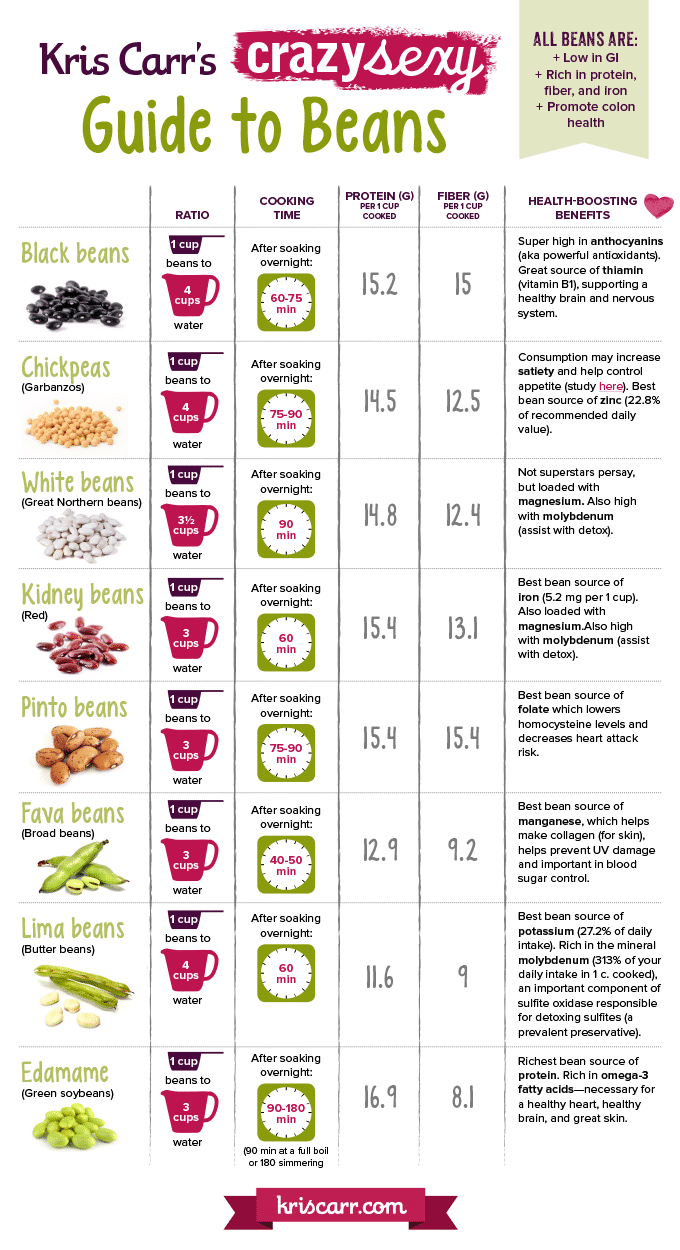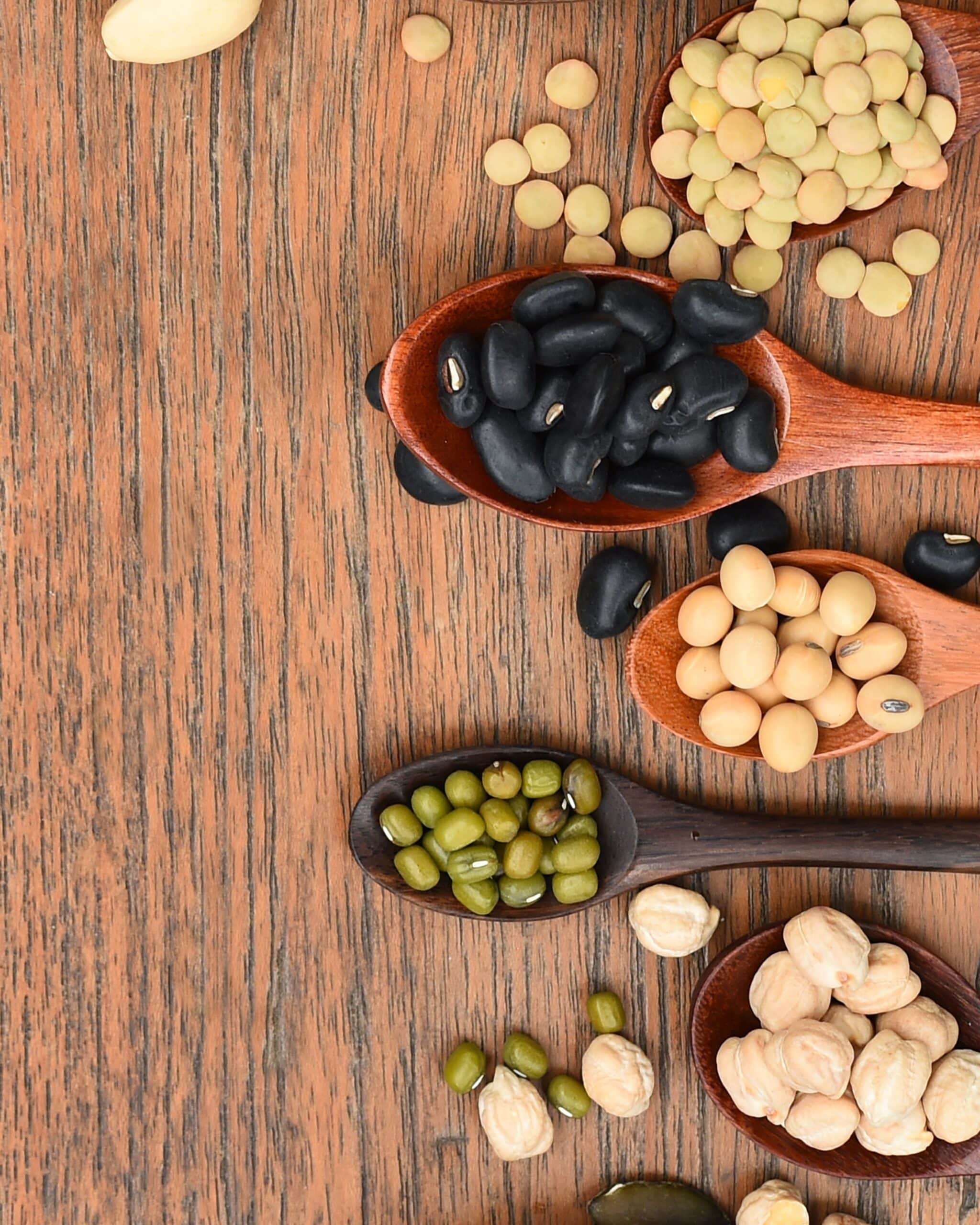Hi Beautiful,
Does this charming chant ring a bell? Beans, beans, the magical fruit. The more you eat, the more you… toot! Whether this tune gives you the giggles or makes you blush, you get the point: beans wake up your gut!
Beans are an essential component to any plant-based diet.
They’re loaded with protein and fiber and add heft and heartiness to any meal. Did you know that there are more than 800 varieties of beans? Holy abundance!
What you may not realize is that the more you eat beans, the better you feel. And there are many things you can do to make friends with this fibrous food if you find that they cause some digestive discomfort. (Get loads of tips here!) Since I’m such a huge fan of these thrifty, nourishing and tasty members of the plant family, I feel a little education on this pantry staple is in order. And I turned to my handy-dandy cookbook, Crazy Sexy Kitchen for some assistance… Let’s start with the basics.
How do you choose the best beans?
Dried or canned?
I buy dried beans in bulk (saves money!) and store them in mason jars. But it’s always good to have a few cans around for those times when you haven’t soaked your beans and are in a rush. When buying canned beans look for BPA-free products without preservatives, such as calcium disodium EDTA. Also, try to use low-sodium varieties and make sure to rinse them well (no need to pickle yourself!).
Bonus tip: Brands like Eden add kombu (seaweed) to their canned beans, which make these tasty dudes easier to digest.
How to prep for ultimate pep!
First, let’s learn about enzyme inhibitors and phytic acid. Beans, seeds, and legumes contain enzyme inhibitors, which delay germination (when a plant emerges from its seed and sings, “Hello, world!”). In nature, rain triggers germination. If we eat these foods before soaking, then it hasn’t “rained” yet and the enzyme inhibitors and phytic acid are still intact. Who cares? Your belly!
Enzyme inhibitors block and bind with our digestive and metabolic enzymes. What are they? Digestive enzymes help to break down our food, while metabolic enzymes support every amazing function in our bodies. Bottom line, we don’t want to mess with them. Soaking beans triggers germination which neutralizes enzyme inhibitors.
Phytic acid in the body decreases our ability to absorb key minerals, such as calcium, iron, magnesium, and zinc. These minerals are crucial for peppy health. Soaking our beans until they germinate activates the chemical phytase, which is an enzyme that neutralizes phytic acid. Voilà!
How to cook your beans
Step 1: Draw Your Beans A Bath
Place them into a bowl filled with water. Swish the little suckers around, strain, and repeat until the water is clear. This helps to remove dusty residue and the occasional dead bug (ew!), not to mention stones. Yup, from time to time you might find a little rock in your batch. Protect your choppers with a quick sift.
Step 2: Soak, Soak, Soak!
As we just mentioned, soaking your beans overnight will greatly reduce enzyme inhibitors and phytic acid, making them easier to digest (less toots!). Just be sure to use fresh water for cooking. Even if you can only soak them for a few hours, it helps and your body will thank you. And get this: soaking beans for around 18 hours can reduce phytic acid by 50 to 70 percent. Dang! Plus, soaking your beans first will reduce cooking time.
Bean Bonus: Adding a piece of kombu (seaweed) increases the effectiveness of this process.
Step 3: Boil, Baby!
Just about all dry beans have a similar cooking method. Start with cold water and beans in a large pot. Bring to a boil and then turn down to a simmer. Cover the pot, leaving the lid tilted just enough to allow some steam to escape. Beans are done when they are tender and the skin is still intact.
Tip time: What’s Up With Salt?
Salt pulls moisture from beans, so wait until they’re almost tender then add salt to the cooking water. You’ll avoid adding too much sodium, which would just get lost during the cooking process.
Your Ultimate Bean Chart
Get your bean facts at a glance, plus cooking tips with your fun and fabulous Crazy Sexy Guide to Beans!

Cha-cha-cha-CHILI!
Ready to get your legume on? Try Crazy Sexy Kitchen’s out-of-this-world Crazy Sexy Bean Chili!
So tell me, what bean-tastic ways do you enjoy this magical plant? Share your favorite bean recipe or cooking/storing/buying tip in the comments below!
Peace & fabulous fiber,




So, can anyone tell me when I should add the kombu to beans? Cause in this article, it looks like it should be added while soaking, but in another article that Kris wrote, it says to add it when boiling the beans…
Have you ever tried pressure cooking the soaked beans? I regularly make chickpeas and blackbeans at home. Soaked overnight I pressure cook the blackbeans for 10 minutes (at pressure) and 12 minutes for the chickpeas. A huge batch and put the cooked beans in the freezer in whatever portion size you use most. I mostly make hummus (6cups at a shot) and black bean brownies.
We take it to the next level and sprout all of our beans, and grains because that’s when they are easiest to digest and peak in available nutrients. It’s just another few easy steps, drain after soaking overnight, rinse a couple of times a day, keep covered with mesh or cloth so nothing gets in and in a few days you’ll have the most nutrient dense sprouted beans to cook. We freeze some after cooking to have them ready to go when needed.
I make killer chili & amazing bean soups using Better Than Bullion. My secret ingredient.
My eyebrow raised when I read about this bean topic. Beans have been prohibited at home because of its phytic acid which is a huge no-no for my mom. We had to go along with her no-bean-diet to make it easier for her. That’s a great guide you made on the bean soaking process to reduce the phytic acid content and kudos on the nutrient breakdown for all the healthy beans.
What about lentils….do you have to soak them?
LOL… there are so many versions of that little ditty. The one I usually use is:
Beans, beans, are good for a hoot, the more you eat, the more you toot.
But yes, love my beans… wish my family liked them more since they’re so great for you.
I was wondering if you could tell me how to store beans that have been soaked for quick preparation. I love beans but hate cans and would love to get away from using canned beans if possible. Love your site and how knowledgeable you are! Thank you for taking the time to share, it is very much appreciated!
Thank you for this guide and the tip on when to add salt I did not know that.
I absolutely love beans and eat them every day. I always thought the bloating and gas issues came from the beans themselves. But for me, when I gave up dairy and stopped putting cheese and sour cream on top of my beans, all of those symptoms went away. Now I enjoy them with no problems at all! Thank you for the guide.
Susie
I bought a pressure cooker a couple months ago after a friend suggested it.Wow! What a huge difference.Quicker and easier.I still soak the beans ahead.I had trouble getting the proper texture before so I just used canned.Not anymore.It has been a great investment.
I made the Crazy Sexy Bean Chili – It was awesome. I did make a change. I used sweet potato instead of white and eliminated the maple syrup. I needed to increase the cooking time to 45 minutes because of the sweet potatoes.
My husband loved it!!
Are refried beans healthy? I buy the canned vegetarian kind.
Sousboontjies (Sweet and Sour Beans)
1 c Sugar beans, soaked or 1 can Butter Beans
2 Tb Sugar
4 tb Vinegar
Himalaya Salt / Black pepper to taste
2 Tb Butter
Drain the water from the sugar beans. Cover the beans with fresh, cold water and cook until beans are tender. Drain the beans again and place them in a pan over low heat. Add butter, sugar and vinegar, shaking the pan. Add salt and pepper. Simmer the ingredients for 15 minutes on the lowest possible heat. Serve the beans hot or bottle them and store in refrigerator.
Enjoy
I love Kidney beans in almost everything from salads to soup. Since they have a toxin that requires they be boiled for 10 minutes before I put them in my slow cooker I actually boil a huge batch for 10 minutes and then freeze them in 3 cup ziplock baggies to store for later usage so I don’t have to try to find the time to boil them in the morning before work. Saves time and hassle.
I use red beans. I cook on dimmer for a few hours with fresh garlic, shallots, onions…. Then last 30 minutes add cumin, salt, fresh cilantro, parsley…mmmh good .
And an added mama recipe.. In a separate sauce pan scoop out bean liquid about a cup and the cooked beans, bring to a boil and crack an egg..cook until hard boiled
Serve with sour cream ..or a substitute … Really it is tasty .
Kris You are A Pillar! An inspiration, and a beauty thank Angels for You!
Hi Kris,
Do you soak canned beans as well?
Much love xo
nanda
Canned beans are generally already soaked and cooked – ready to eat cold as a bean salad or to heat till hot enough for the palette tolerance. Linda
I love all kinds of beans but always bought canned beans because I was never really sure of the process of rinsing and soaking. Now I can’t wait to try and I’m looking forward to making the chili. Thanks.
I’ve read you can put dried beans in a slow cooker and cook for 4-6 hours depending on the bean.
Do you just leave beans on counter to soak or should they be in refrigerator?
Thanks!